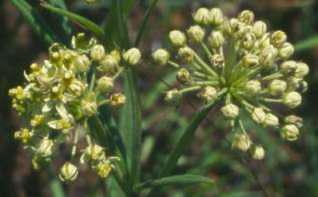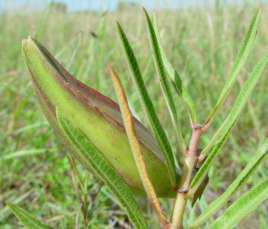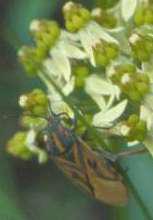Xysmalobium involucratum
Xysmalobium involucratum (E.Mey.) Decne.
Family: Apocynaceae
Common names: scented xysmalobium (Eng.); hongersnoodwortel, hongersnoodbossie, melkbossie (Afr.); udambisomkhulu, udelunina (isiZulu)
Introduction
The long, narrow, green leaves make Xysmalobium involucratum inconspicuous in unburned grassy areas unless it is flowering. In grasslands that are grazed by livestock and game it is even more difficult to see the flowers as the plant is browsed together with other plants.

Description
Description
X ysmalobium involucratum is a perennial herb. It has a carrot-like stem-tuber from which arise 1-3 decumbent or erect simple stems which are 150-360 mm high. The stems are either almost hairless with two vertical rows of fine hairs, or with hairs all round. Remnant stems of the previous season often form a rosette at the base. The leaves have short stalks that are 1-4 mm long; the leaves are erect or ascending, numerous and opposite, are 35-130 x 1-9 mm, and both surfaces can have hairs or not. The margins are rolled backwards and downwards. Milky latex exudes when plant parts are broken.
The flowering time is between September and February. Flowers are in compact heads, 1-5 heads to a stem. Petals are turned back abruptly to expose the corona and anthers, slightly hairy on the back and without hairs within. The flower colour varies from whitish-green, pale creamy-green to yellowish-green or greenish-brown. In some instances flowers are not scented. When they are scented, they smell like a ripe watermelon, and are strongly or sickly sweet-scented. If fresh flowers are left in a confined environment, the scent is strong enough to cause a headache. Corona lobes are yellowish green to brown.
The fruit is solitary, occasionally paired, erect, 60-170 x 5-15 mm, and tapering to a beak. It is smooth or with minute hairs.

Conservation Status
Status
X. involucratum is not yet in the Red Data List, but may become threatened soon as a result of loss of habitat because of monoculture plantations and its use in traditional medicine.
Distribution and habitat
Distribution description
This species is common and widespread in grasslands of the southern African region only. It is found in all provinces of South Africa, except Limpopo. It also occurs in Lesotho but there are no records of it being found in Swaziland. It grows in many different types of habitat over a wide range of altitudes from sea level to the grasslands of Lesotho.

Derivation of name and historical aspects
History
Research using new technology has resulted in the family Asclepiadaceae and other related families being recently reduced to subfamily level under the family Apocynaceae. Xysmalobium is derived from the Greek, xusma meaning fragment, shavings; lobos meaning lobe, division, referring to the divisions of the corona. Involucratum refers to the turned back petals that resemble involucral bracts. There are 480 genera and 4 800 species in the Apocynaceae family, most of them found in tropical and warm areas, especially Africa. A few are found in temperate regions. In the genus Xysmalobium, there are about 40 species in Africa and 21 in southern Africa, widespread in grassland of all countries.
Ecology
Ecology
A number of different, mostly small or medium-sized, insects have been observed visiting flowers. However, it has never been conclusively established if they are pollinators. Seeds are dispersed by wind. It is difficult to understand how this diminutive species is so successful since fruiting plants are seldom seen. Its fruits are browsed mostly by game and cattle, sometimes well before they reach maturity.

Uses
Use
One of its isiZulu names is udelunina which literally means forsaking one's mother (dela = to forsake; nina =mother). It refers to the use of the plant: if ingested by a girlfriend/boyfriend, that person leaves her/his mother to live with his/her partner. The stem-tuber is also used to make a concoction to sprinkle around the homestead as a protective charm.
Growing Xysmalobium involucratum
Grow
This is a grassland plant that survives in cultivation but prefers to be in a grassland environment that is sometimes subjected to fire, where it grows surrounded by grasses and other plants. These other plants provide shade to the root, thereby helping to maintain a cooler microclimate at soil level or just above it at 30 cm. It will die if grown in a bare bed or in soil that is not mulched. In such a situation mealy bug can be a pest to the root and new growing shoots.
For better results there should be more diverse plants growing around this species. It is useful to observe this plant in the wild to see which other species grow near to it. Obviously each region of the country will have different species.
Parent plants form an extensive underground stem-tuber that is able to survive the regular fire that sweeps through the grassland habitat that it occupies.
This species is best grown from seed that is ripe in late summer. Once the large bladder-like follicles are ripe, they split to reveal the seeds attached to their silken-haired parachutes that are used for dispersal. Sow the seeds in a well-drained seedling mixture after removing the silky hairs. The mixture should be made up of river sand and well-rotted compost, mixed in a ratio of 1:1. Seeds need to be germinated in a sunny, warm position. Cool soil and air temperature cause the seeds to take longer to germinate. Seedlings take about 10 days to germinate depending on the temperature.
In parts of the country, at high altitude, sowing the seeds should be held off until the following growing season. This gives seedlings the whole growing season to establish themselves before the cold and dry winters. This cultivation method can also be applied to the more commonly seen and used Xysmalobium undulatum which sometimes grows as a weed. Propagation by cuttings is worth a try.
References
- Brown, N.E. 1909. Asclepiadeae. Flora capensis, vol. 1,V, sect.
- Germishuizen, G. & Meyer, N.L. (eds). 2003. Plants of southern Africa: an annotated cheklist. Strelitzia 14.
- Hutchings, A.; Scott, A.H.; Lewis, G. & Cunningham, A. 1996. Zulu medicinal plants, an inventory .University of Natal Press, Pietermaritzburg.
- Langley, R.W. 1980. Taxonomic studies in the Asclepiadeae with particluar reference to Xysmalobium R.Br. in southern Africa (Asclepiadaceae) . M.Sc. thesis, Univeristy of Pietermaritzburg.
- Leistner, O.A. (ed.). 2000. Seed plants of southern Africa: families and genera. Strelitzia 10. National Botanical Institute, Pretoria.
- Ngwenya, M.A., Koopman, A. & Williams, R. 2003. Ulwazi LwamaZulu Ngezimila: isingeniso/Zulu Botanical Knowledge: an introduction . National Botanical Institute, Durban.
- Nicholas, A. 1999. A taxonomic reassessment of the subtribe Asclepiadinae (Asclepiadaceae) in southern Africa. Ph.D. thesis, University of Durban-Westville.
- Pooley, E. 1998. A field guide to wild flowers of KwaZulu-Natal and the Eastern Region. Natal Flora Publications, Durban.
- Smith, C.A. 1966. Common names of South African plants. Memoirs of the Botanical Survey of South Africa No. 35.
Credits
Mkhipheni Ngwenya
KwaZulu-Natal Herbarium
November 2004
Plant Attributes:
Plant Type: Perennial
SA Distribution: Eastern Cape, Free State, Gauteng, KwaZulu-Natal, Mpumalanga, North West, Northern Cape, Western Cape
Soil type: Loam
Flowering season: Spring, Early Summer
PH: Neutral
Flower colour: Brown, Green, Cream, Yellow
Aspect: Full Sun
Gardening skill: Average
Special Features:
Horticultural zones











Rate this article
Article well written and informative
Rate this plant
Is this an interesting plant?
Login to add your Comment
Back to topNot registered yet? Click here to register.